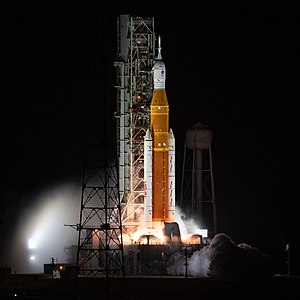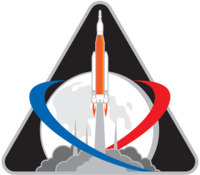
Back Artemis 1 Afrikaans أرتيمس 1 Arabic Артемида 1 Bulgarian আর্টেমিস ১ Bengali/Bangla Artemis 1 BS Artemis I Catalan Artemis I Czech Artemis 1 Welsh Artemis 1 German Artemis 1 Greek
This article needs to be updated. The reason given is: critical issues in Artemis 1 as reported in the Office of Inspector General's NASA’s Readiness for the Artemis II Crewed Mission to Lunar Orbit report. (May 2024) |
 The Space Launch System launches from Kennedy Space Center's LC-39B | |
| Names |
|
|---|---|
| Mission type | Uncrewed lunar orbital test flight |
| Operator | NASA |
| COSPAR ID | 2022-156A |
| SATCAT no. | 54257 |
| Website | www |
| Mission duration | |
| Distance travelled | 1.3 million miles (2.1 million kilometers) |
| Spacecraft properties | |
| Spacecraft | Orion CM-002 |
| Spacecraft type | Orion MPCV |
| Manufacturer | |
| Start of mission | |
| Launch date | November 16, 2022, 06:47:44 UTC (1:47 am EST)[3] |
| Rocket | Space Launch System Block 1 |
| Launch site | Kennedy Space Center, LC-39B |
| End of mission | |
| Recovered by | USS Portland[5] |
| Landing date | December 11, 2022, 17:40:30 UTC (9:40:30 am PST)[2] |
| Landing site | Pacific Ocean off Baja California[4] |
| Orbital parameters | |
| Reference system | Selenocentric |
| Regime | Distant retrograde orbit |
| Period | 14 days |
| Flyby of Moon | |
| Spacecraft component | Orion |
| Closest approach | November 21, 2022, 12:57 UTC[6] |
| Distance | 130 km |
| Moon orbiter | |
| Spacecraft component | Orion |
| Orbital insertion | November 25, 2022, 21:52 UTC[7] |
| Orbital departure | December 1, 2022, 21:53 UTC[8] |
| Flyby of Moon | |
| Spacecraft component | Orion |
| Closest approach | December 5, 2022, 16:43 UTC[9] |
| Distance | 128 km |
 Artemis 1 mission patch | |
Artemis 1, officially Artemis I[10] and formerly Exploration Mission-1 (EM-1),[11] was an uncrewed Moon-orbiting mission. As the first major spaceflight of NASA's Artemis program, Artemis 1 marked the agency's return to lunar exploration after the conclusion of the Apollo program five decades earlier. It was the first integrated flight test of the Orion spacecraft and Space Launch System (SLS) rocket,[note 1] and its main objective was to test the Orion spacecraft, especially its heat shield,[12] in preparation for subsequent Artemis missions. These missions seek to reestablish a human presence on the Moon and demonstrate technologies and business approaches needed for future scientific studies, including exploration of Mars.[13][14]
The Orion spacecraft for Artemis 1 was stacked on October 20, 2021,[15] and on August 17, 2022, the fully stacked vehicle was rolled out for launch after a series of delays caused by difficulties in pre-flight testing. The first two launch attempts were canceled due to a faulty engine temperature reading on August 29, 2022, and a hydrogen leak during fueling on September 3, 2022.[16] Artemis 1 was launched on November 16, 2022, at 06:47:44 UTC (01:47:44 EST).[17]
Artemis 1 was launched from Launch Complex 39B at the Kennedy Space Center.[18] After reaching Earth orbit, the upper stage carrying the Orion spacecraft separated and performed a trans-lunar injection before releasing Orion and deploying ten CubeSat satellites. Orion completed one flyby of the Moon on November 21, entered a distant retrograde orbit for six days, and completed a second flyby of the Moon on December 5.[19]
The Orion spacecraft then returned and reentered the Earth's atmosphere with the protection of its heat shield, splashing down in the Pacific Ocean on December 11.[20] The mission aims to certify Orion and the Space Launch System for crewed flights beginning with Artemis 2,[21] which is scheduled to perform a crewed lunar flyby no earlier than September 2025.[22] After Artemis 2, Artemis 3 will involve a crewed lunar landing, the first in five decades since Apollo 17.
- ^ "Artemis 1 Press Kit" (PDF). Archived (PDF) from the original on November 15, 2022. Retrieved November 16, 2022.
- ^ a b "NASA Prepares Rocket, Spacecraft Ahead of Tropical Storm Nicole, Re-targets Launch". NASA. November 8, 2022. Archived from the original on November 8, 2022. Retrieved November 8, 2022.
- ^ Cite error: The named reference
reuters 1was invoked but never defined (see the help page). - ^ Davis, Jason. "Artemis I launch guide: What to expect". The Planetary Society. Archived from the original on August 15, 2022. Retrieved August 24, 2022.
- ^ "Artemis 1 flight to moon depends on precision rocket firings to pull off a complex trajectory". CBS News. Archived from the original on August 29, 2022. Retrieved August 31, 2022.
- ^ Cite error: The named reference
NASA_20221120was invoked but never defined (see the help page). - ^ Cite error: The named reference
Flight Day 11was invoked but never defined (see the help page). - ^ Cite error: The named reference
Flight Day 16was invoked but never defined (see the help page). - ^ Cite error: The named reference
Flight Day 20was invoked but never defined (see the help page). - ^ Artemis: brand book (Report). Washington, D.C.: NASA. 2019. NP-2019-07-2735-HQ.
MISSION NAMING CONVENTION: While Apollo mission patches used numbers and roman numerals throughout the program, Artemis mission names will use a roman numeral convention.
 This article incorporates text from this source, which is in the public domain.
This article incorporates text from this source, which is in the public domain.
- ^ Hambleton, Kathryn (February 20, 2018). "Artemis I Overview". NASA. Archived from the original on August 17, 2022. Retrieved August 24, 2022.
- ^ "NASA: Artemis I". NASA. Archived from the original on March 15, 2022. Retrieved November 17, 2022.
- ^ Dunbar, Brian (July 23, 2019). "What is Artemis?". NASA. Archived from the original on August 7, 2019. Retrieved November 17, 2022.
- ^ "Stowaways on NASA's massive Moon rocket promise big science in small packages". Science.org.
- ^ "NASA Fully Stacked for Moon Mission, Readies for Artemis I". NASA. October 23, 2021. Archived from the original on November 17, 2022. Retrieved November 17, 2022.
 This article incorporates text from this source, which is in the public domain.
This article incorporates text from this source, which is in the public domain.
- ^ Foust, Jeff (September 3, 2022). "Second Artemis 1 launch attempt scrubbed". SpaceNews. Archived from the original on November 17, 2022. Retrieved September 4, 2022.
- ^ "Artemis 1". NASA. Archived from the original on December 19, 2022. Retrieved November 17, 2022.
- ^ "Artemis 1 Presskit" (PDF). Archived (PDF) from the original on November 15, 2022. Retrieved August 31, 2022.
- ^ Sloss, Philip (November 1, 2021). "Inside Artemis 1's complex launch windows and constraints". NASASpaceflight.com. Archived from the original on February 25, 2022. Retrieved March 25, 2022.
- ^ Cite error: The named reference
Splashdownwas invoked but never defined (see the help page). - ^ Clark, Stephen (May 18, 2020). "NASA will likely add a rendezvous test to the first piloted Orion space mission". Spaceflight Now. Archived from the original on July 8, 2020. Retrieved May 19, 2020.
- ^ Foust, Jeff (January 9, 2024). "NASA delays Artemis 2 and 3 missions". SpaceNews. Retrieved January 10, 2024.
Cite error: There are <ref group=note> tags on this page, but the references will not show without a {{reflist|group=note}} template (see the help page).
© MMXXIII Rich X Search. We shall prevail. All rights reserved. Rich X Search